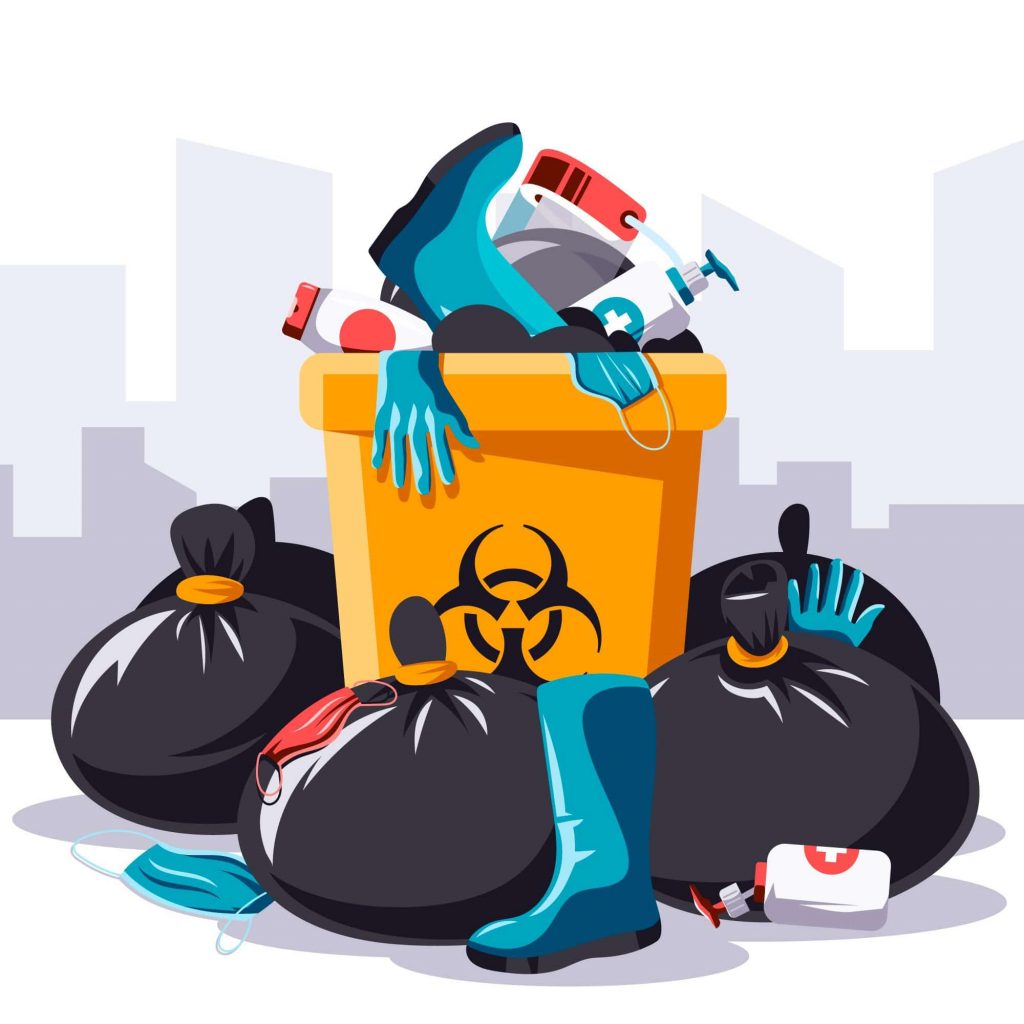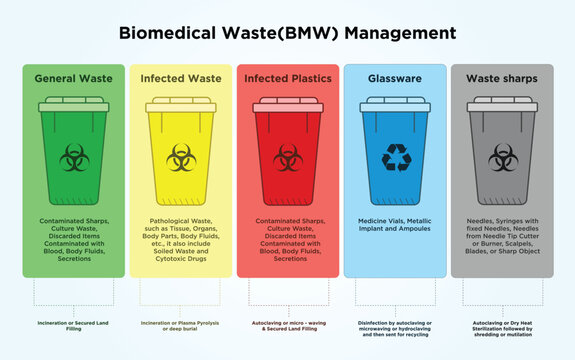Efficient and Liable Medical Waste Removal: Protecting Individuals and the Earth
Wiki Article
Compliance and Regulations for Medical Waste Disposal
Conformity and guidelines for clinical waste disposal play a vital function in ensuring the safety and security and well-being of both healthcare specialists and the general public. Correct administration of medical waste is crucial to prevent the spread of infections, protect the atmosphere, and preserve public wellness. These policies encompass different elements, including the category and segregation of clinical waste, correct storage and handling treatments, as well as transportation and disposal techniques.Significance of Conformity
The significance of compliance with regulations for medical waste disposal can not be overemphasized. Correct disposal of clinical waste is critical for ensuring the safety and health of medical care employees, clients, and the general public. Medical waste, which consists of things such as utilized needles, polluted gloves, and biomedical waste, can pose serious wellness dangers if not dealt with and gotten rid of appropriately.Compliance with regulations ensures that clinical waste is taken care of in a manner that decreases the possibility for exposure to infectious diseases and harmful substances - medical waste disposal. It helps protect against the spread of infections, such as HIV, hepatitis B and C, and various other bloodborne microorganisms. Conformity also plays an important duty in safeguarding the setting by preventing contamination of water resources, dirt, and air
Failing to follow laws can result in extreme repercussions for medical care facilities, consisting of fines, legal activity, and damage to their online reputation. Furthermore, non-compliance might jeopardize the health and wellness of health care workers, clients, and the area.
Compliance with guidelines for clinical waste disposal needs adherence to details guidelines and methods. These might include correct segregation, product packaging, labeling, and storage of clinical waste. It likewise entails utilizing approved disposal methods, such as incineration, landfilling, or autoclaving, depending on the sort of waste.
Regulative Agencies and Bodies
Regulatory companies and bodies play a vital role in supervising conformity with policies for clinical waste disposal. These organizations are accountable for setting procedures, requirements, and guidelines to make sure the secure and correct handling of medical waste. They implement and check conformity to protect public health and the environment.Among one of the most prominent regulatory agencies in the USA is the Epa (EPA) The EPA is accountable for regulating the storage, transportation, treatment, and disposal of medical waste. They establish guidelines for waste generators, transporters, and therapy centers to adhere to, ensuring that all necessary precautions are required to protect against the spread of conditions and contamination.
An additional vital governing body is the Occupational Safety and Health Administration (OSHA) OSHA establishes laws and standards to protect workers from occupational hazards, consisting of those relevant to clinical waste. WasteX Medical Waste Disposal. They provide guidelines for the secure handling and disposal of clinical waste to secure staff members in medical care centers
In enhancement to these government firms, individual states likewise have their own regulatory bodies that manage medical waste disposal. These companies may have their own particular policies and needs that should be adhered to.

Classification and Segregation of Clinical Waste
To ensure proper monitoring of clinical waste, it is necessary to categorize and segregate it according to established protocols and guidelines. medical waste removal. Classification and segregation play an important role in decreasing the danger of infection, securing the setting, and guaranteeing the security of health care employees and the basic publicMedical waste is classified into different classifications based on its prospective threat degree. These groups include infectious waste, pathological waste, sharps waste, pharmaceutical waste, chemical waste, and radioactive waste. Each category requires particular handling, transport, disposal, and storage space methods to reduce the risk of exposure and contamination.
Segregation of clinical waste entails dividing various kinds of waste at the source. This procedure ensures that waste with various threat degrees is not blended, minimizing the possibility for cross-contamination and making disposal treatments a lot more effective. Appropriate segregation is achieved via the usage of color-coded labels and containers, which help healthcare workers and waste monitoring workers determine and deal with each type of waste correctly.
In addition to category and segregation, healthcare centers need to also stick to regional, state, and federal regulations regarding clinical waste management. These regulations outline certain requirements for storage, transport, treatment, and last disposal of medical waste, ensuring conformity and maintaining public wellness and security.
Appropriate Storage Space and Managing Procedures
Appropriate storage and dealing with procedures play a crucial role in making certain the secure and compliant administration of medical waste. Medical waste, which consists of things such as made use of syringes, polluted gloves, and ended medications, can position serious health and environmental risks otherwise handled appropriately. It is crucial for medical care facilities and other generators of clinical waste to carry out stringent storage and taking care of procedures.
To begin with, clinical waste needs to be saved in sturdy, watertight containers that are particularly made for this purpose. These containers must be identified with the global biohazard symbol and words "clinical waste" to plainly suggest the materials. Furthermore, the containers must be maintained firmly near avoid any type of possible leakage or spillage.
In addition, it is essential to segregate various sorts of clinical waste to stop cross-contamination. Sharps, such as needles and scalpels, must be saved in puncture-resistant containers to minimize the risk of injuries - WasteX Medical Waste Disposal. Chemical waste, such as disinfectants and solvents, ought to be kept individually from various other kinds of medical waste to avoid chain reactions or harmful direct exposures

Transport and Disposal Methods
Healthcare centers need to guarantee the safe transport and appropriate disposal of their medical waste to follow laws and safeguard public health. Transport and disposal methods play an essential duty in stopping the spread of infectious conditions and reducing the ecological influence of medical waste.
To carry clinical waste, healthcare centers should make use of puncture-resistant and watertight containers that are labeled with the biohazard icon. These containers should be firmly sealed to stop any leak throughout transportation. In addition, healthcare centers should establish methods for the transportation procedure, consisting of the use of committed automobiles and trained workers.
When the clinical waste reaches the disposal center, it undertakes various techniques of therapy. One common method is incineration, which includes melting the waste at high temperatures to ruin view it now virus and reduce the quantity of waste. An additional method is autoclaving, which uses heavy steam and stress to sterilize the waste. After treatment, the waste is commonly sent to a landfill or a waste-to-energy facility for last disposal.
It is important for healthcare facilities to work with accredited and allowed waste administration business to make sure appropriate transport and disposal of medical waste. These business have the proficiency and resources to handle medical waste safely and in conformity with regulations.
Conclusion
In conclusion, compliance with policies for medical waste disposal is of utmost significance to make sure public wellness and safety and security. Regulatory agencies and bodies play an important role in enforcing these policies. Proper classification and segregation of clinical waste, in addition to following appropriate storage space and taking care of procedures, are necessary to stop contamination and the spread of illness. Appropriate transport and disposal methods must be carried out to lessen ecological impacts. In general, adherence to compliance and guidelines is required to properly handle clinical waste.Clinical waste, which includes things such as used needles, polluted handwear covers, and biomedical waste, can position significant health dangers if not taken care of and disposed of correctly.
These groups consist of infectious waste, pathological waste, sharps waste, pharmaceutical waste, chemical waste, and contaminated waste.Partition of clinical waste involves separating various kinds of waste at the source. Appropriate partition is attained through the use of color-coded tags and containers, which help health care employees and waste monitoring workers deal with each type and determine of waste appropriately.
Chemical waste, such as disinfectants and solvents, ought to be saved independently from other types of clinical waste to protect against chemical reactions or unsafe exposures.
Report this wiki page